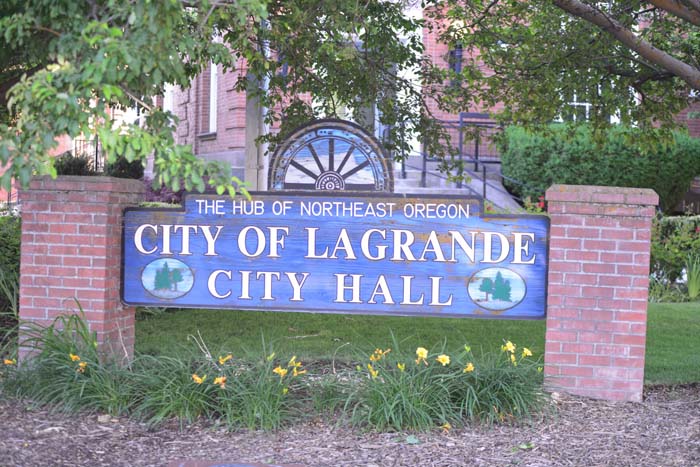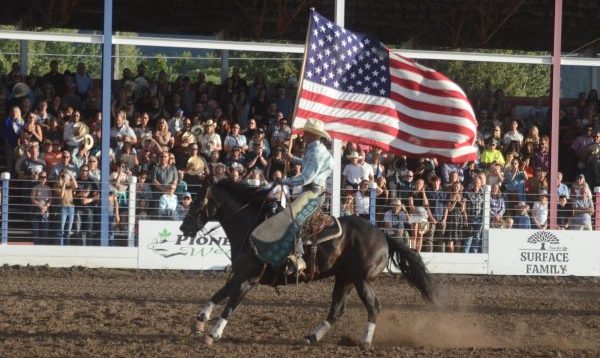CJD Memories from the 1949 Court
Published 6:00 am Wednesday, July 10, 2019

- As this ad in the July 28, 1949 Wallowa County Chieftain notes, the 1949 Chief Joseph Days celebration ran for three days. It included a carnival and speedboat races, as well as the rodeo.
Chief Joseph Days began 74 years ago in 1946. And while many memories of that original rodeo have faded, those of 1949 Court members Ruby Mallon Zollman and Marian Mawhin Birkmaier and are still as fresh as the day they were made. Both former court members are Wallowa County natives, and now live in Joseph.
In 1949, Birkmaier said, the members of the Chief Joseph Days court were selected from each of the principal schools in the community. “They were high school seniors who were voted on by the students and faculty as someone who could represent the school and their community well,” she said. “We weren’t chosen for our ability to ride.” Queen Beverly Oliver hailed from Wallowa, Ruby Mallon (now Ruby Zollman) represented Joseph and Marian Mawhin (now Marian Birkmaier) represented Enterprise.
Trending
“Back then,” Zollman said, “the Chamber of Commerce didn’t have hardly any money. But they decided they needed a rodeo court, and people would be really enthusiastic if each community had a member on the court. So in the last week of May, they got each school to pick a court member. My high school (Joseph) voted. I rode horses and I’d grown up on a ranch, so the class stood behind me.”
In 1949 the rodeo court had special outfits. But their overall wardrobe was pretty limited, “We had to pay for the clothing ourselves,” Zollman said. ”You took what they had. Sizes didn’t always fit real well. But they were big enough that I can still wear mine. I’m going to wear mine this year.”
“We went to a little western store in Joseph where they had lots of different kinds of western wear,” Marian Birkmaier recalled. ”We got a hat, a pair of boots, one pair of gabardine pants, and a shirt—one was brocade, for riding and wearing during the day and the other was sateen, for the dances. That was it, except that Harley Tucker’s wife, Bonnie brought the brocade shirts for us back from a trip she took to Denver.”
Then, as now, the young woman who sold the most tickets was crowned queen. But in 1949, they had only one frantic week for ticket selling. Zollman and two of her friends drove a jeep all over the county. “We sold tickets every day that week,” she said. “We drove from Hurricane Creek to Lower Imnaha and all the way up to the Pallette Ranch. We knocked on every door. And I tell you, there were a lot of doors.” Every night an anonymous donor filled the jeep’s gas tank. “The community stood behind me 100 percent,” Zollman said.
Master storyteller Mack Birkmaier recounted the humorous tale of how moths completely disrupted the 1949 Coronation Dance. “We had lights strung across the dance floor outside,” he said. “Then it started getting dark, really dark. We looked up and there were moths and light-colored smaller moths called millers collecting on the lights. They sort of looked like big hornet nests. Then the millers began falling off the big globs of moths that were clinging to the light bulbs. They started flying up the girl’s dresses and dropping down everyone’s shirts. It sort of stopped the whole show.”
The 1949 court’s duties included riding horses in the parade, and also making a dramatic, galloping entrance at the start of the rodeo. “Marian and I both had to borrow horses,” Zollman said. “My family had moved into town during the war (WWII). So we didn’t have horses—and I didn’t have a saddle.” A classmate lent her a saddle, and a local cowboy who was going to compete in the rodeo said she could use his calf-roping horse. “It’s going to be at the rodeo grounds all the time, anyway,” he said. Zollman was set.
Trending
The 1949 rodeo was only the second show ever held in the newly constructed arena. Temperatures were torrid for Wallowa County — highs in the 90’s. A total of 82 cowboys entered the contests, including Eddie Acreage, who had just won the all-around title at the prestigious Calgary Stampede. Mr. Acreage rode away with the all-around cowboy title at Chief Joseph Days as well. “We had some really good riders at those early rodeos,” Ruby Zollman said.
“Back in those days,” said Marian’s husband, rancher Mack Birkmaier, “many of the cowboys in the rodeo were pretty local. And a lot of them worked on ranches. A few came from Lewiston or Walla Walla, but that was a long way to haul a horse. To have a cowboy from so far out of the area as Acreage was kind of unusual.” Mack also remembers that the bulls were all Brahma bulls. “They weren’t as mean as those bulls today,” he said. “They weren’t out to get you.”
Seventy years ago, additional attractions of Chief Joseph Days included speedboat races on Wallowa Lake for boats with 22 hp, 33 hp and 50 hp outboard motors. Midwest Shows Carnival provided extra entertainment for rodeo-goers, along with the Nez Perce Indian band which was organized and conducted by celebrated actor and local rancher Walter Brennan. Although the Nez Perce and other Native American presence was substantial, Marian Birkmaier recalled that Indians all had to sit in the northeast section of the stands, which faced into the afternoon sun.
A national attention-getter for the 1949 rodeo was the presence of Mrs. Juanita O’Connell of Hollywood, California. Mrs. O’Connell was a winning contestant on the very popular Mutual Broadcasting radio program “Queen for a Day.” That program, hosted by Jack Bailey, brought women who had endured financial and emotional hard times, and a variety of significant traumas or losses onto the air. Each contestant was asked what she needed most. The requests ranged from medical care for a polio-stricken child, to a new washing machine, and often found the contestants sobbing as they described their needs. One of Mrs. O’Connell’s rewards for her winning plea was to be the “Queen for a Day” at the 1949 rodeo, which she did on Friday, July 29, replacing Queen Beverly Oliver. The rodeo court rode their horses out to the Joseph Airport to welcome O’Connell, Zollman recalled. But, Birkmaier said, instead of galloping around the arena on horseback, O’Connell was driven sedately around the rodeo grounds in a buggy, waving to the crowd. Her tour as rodeo queen for a day also included a ride in a racing speedboat on the lake. “She was a really nice, nice, quiet lady,” Zollman said.
The people of the community and the Chamber of Commerce have always rallied around this rodeo, Zollman said. “People would work at the mill all day and then right after work they would go to the rodeo grounds and they would build, build, build. The town was really behind the rodeo. Chief Joseph Days was something for the community to support, and it put Joseph on the map. The cowboys were good. The livestock was good. It was a good, fast rodeo,” she said. “It was much better than the Pendleton Roundup.”
“The rodeo, and the things that the Rodeo Court do, are so much better now,” Marian Birkmaier said. “But we were there at the beginning. We had a good time.”









